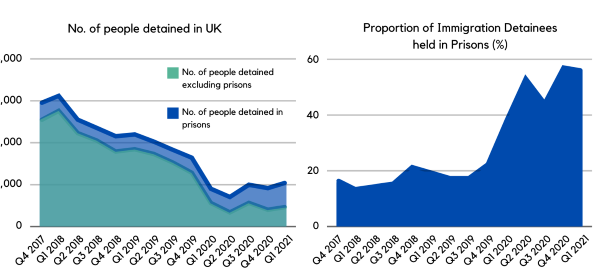Immigration Statistics: Year ending March 2021
The Home Office has released its statistics on immigration detention for the year up until March 2021.
In the year ending in March 2021, 12,967 people entered detention, down 44% since the previous year (23,101) and 12,840 people left detention, down 46% since the previous year (23,962). At the end of March there were 1033 people in detention, down 44% since 2019 (1,637).
These overall numbers mask a few concerning trends in the Government’s use of detention, which has once more been increasing ever since the number of people detained reached its lowest point in a decade in June (when 330 people were held in detention centres and 368 were detained in prisons).
It’s important to ask: if the Government’s stated basis for detaining people is the intention to remove them, was it justified holding anyone in prison or prison-like settings during the pandemic when removal was less likely?
(figures analysed and rounded by AVID)
Increased use of detention in prisons
- The number of people detained in prisons increased by 70% from 340 at the end of March 2020 to 577 at the end of March 2021. This means 56% of those detained overall at the end of March were being held in prisons.

Shorter length of detention?
- In the year ending in March 2021, 64% (8163) of those leaving detention had been held for less than 7 days, up from 38% the preceding year. This is at least in part due to the Government detaining more people directly after they arrived in the UK before they were able to claim asylum.
- However, 2,667(27%) were still detained for more than 28 days and 385 people (3%) held for more than 6 months before leaving.
Removal and returns
- The rate of removal dropped significantly from 35% of those leaving detention in the previous year to 24% (12,840) of those leaving detention in the year until March 2021. This means 76% were released back into their community, their detention having served no purpose.
- Of the 2894 people leaving detention between January and March 2021, 22% (645) were removed from the UK, and so 78% were released back into their community, their detention having served no purpose.
Nationalities
- The most common nationality of people entering detention in the year ending in March 2021 was Iranian, accounting for 14% of the total (1,835), and a 6% increase on the previous year. The next most common nationality of people entering detention was Albanian (1,542), which is around half the number for the previous year. While most other nationalities saw a reduction in numbers entering, there were increases in the number of people with the following nationalities: Syrian (+580) and Sudanese (+574)
- In the year until March 2021, of the 10 nationalities with the most people leaving detention those with the highest rate of removal were Romanian (85%), Brazilian (79%), Polish (63%) and Albanian (23%)
Children in detention
- Between January and March 2021, 10 children (aged under 18) entered detention, 7 of whom were detained in Yarl’s Wood IRC, 2 in prisons and 1 in Colnbrook IRC.
Read more: Cross-border call for release of everyone detained during the pandemic




